Many people grow rhubarb, and according to gardening books it needs a lot of space. By companion planting rhubarb you can make the most of that space and enhance your plants. By growing more plants in a small space you reduce the risk from weeds taking over the area.
In days gone by, they used to grow Rhubarb and Strawberries together, it makes sense, they’re both harvested at about the same time. They also both benefit from being dressed with straw.
I can find no actual benefit for growing rhubarb and strawberries together, maybe Grandad was wrong… More than likely it was a space thing, read on for more reasons to companion plant rhubarb with many other plants.
Rhubarb As A companion Plant
Most vegetable gardens contain a patch of rhubarb, it takes a lot of space but that space can be filled with other vegetables. Plants to grow as companions to rhubarb include:-
- Cabbage
- Broccoli
- Beans
- Garlic
- Onions
- Roses
- Columbines
Companion Planting Rhubarb With Brassicas
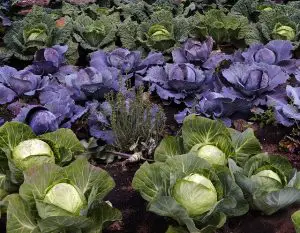
Companion planting rhubarb with cabbage, Broccoli, Kale, Cauliflower or any other member of the brassica family will help to improve the health of your plants.
This is because the smell of rhubarb will repel many insects and pests, such as the white fly, which commonly infests brassica plants.
Companion Planting Rhubarb With Beans
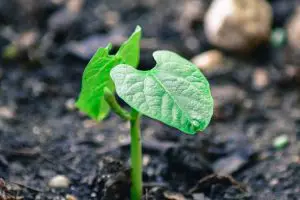
BY companion planting beans with rhubarb you will deter the Blackfly(Aphid) that causes so many problems for bean growers. As beans fix nitrogen in the air, there will be extra nitrogen in the soil for the rhubarb to use. See below how to make a spray using rhubarb leaves to deter pests.
Companion Planting Rhubarb With Onions
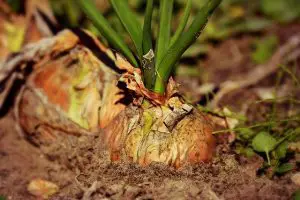
Onions are members of the allium family and have a strong aroma. This is the secret to keeping harmful pests such as aphids and weevils away from your rhubarb plants.
Companion Planting Rhubarb With Garlic
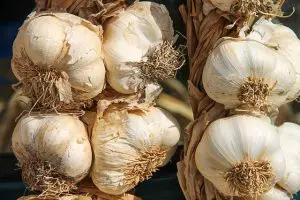
As with onions, the strong aroma from garlic will deter many pests including leaf beetle and to some extent slugs and snails. Leaf beetle will bore through the rhubarb leaves making the plant susceptible to disease and also making plants weaker. Slugs and snails seem to only eat young leaves but the loss of leaves in young plants can be devastating.
Companion Planting Rhubarb With Columbines
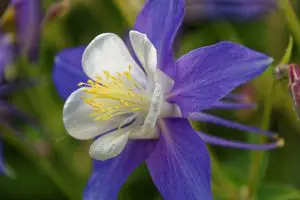
By companion planting rhubarb with Columbines(Aquilegia) will protect them from attack by red spider mite.
Using Rhubarb as a pest deterrent
You can make a spray by boiling up the leaves of rhubarb. Spray this onto beans, cabbages and roses to keep Aphids and white fly away.
Remember that the leaves from rhubarb are poisonous so always wash thoroughly any vegetables that have been sprayed before eating.
Be extra vigilant with your crops as rhubarb do seem to attract slugs, never a good thing when growing vegetables.
What Not To Grow With Rhubarb
Not every companion is a good companion, and in this, rhubarb has it’s problems too.
Rhubarb and Dock Leaves
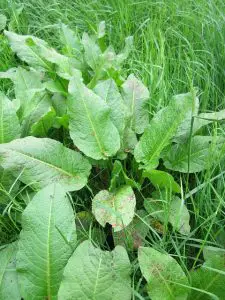
Dock leaves grow a long tap root and broad leaves, and according to popular traditions it eases the pain of a nettle sting. It also attracts a weevil known as the Rhubarb Curculio. This bug bores into the stalk of the rhubarb and makes it none too palatable.
So keep the rhubarb patch free from dock leaves and you are less likely to encounter this problem. It is easy to spot damage from the Rhubarb Curculio because not only will you see a hole in the stalk. But there is also likely to be a clear jelly like liquid covering the hole.
Rhubarb and Sunflowers
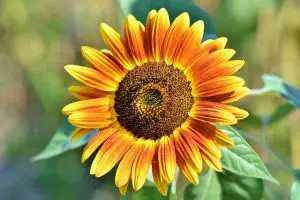
Sunflowers also harbour the Rhubarb Curculio (Lixus concavus) so to ensure a healthy crop of rhubarb grow your sunflowers in a different part of the garden.
Rhubarb and Thistles
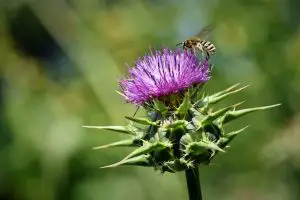
Sometimes thistles can be an attractive addition to the garden, and some varieties are quite tall. You might be tempted to grow some in companion with rhubarb to make a stately display. Don’t do it, thistles are also attractive to the rhubarb Curculio which is one of the main insects to damage rhubarb.
Companion Planting Rhubarb Video Summary
How To Grow Rhubarb
Any piece of rhubarb root will grow given the right conditions. This is fine but does limit the varieties you can grow. I grew some from seed and it took very nicely, it was a variety I had never heard of so it adds another dimension to the plot.
Prepare the soil by adding plenty of organic material and allow about 3 foot(90 centimetres) around each rhubarb plant. Rhubarb is best planted in spring in a fairly sunny spot. Water well and apply a top dressing in autumn.
Mulch with straw to prevent water loss and keep weed growth down although the large leaves of the rhubarb plants help with this. Keep rhubarb well watered and don’t over pick.
How To Harvest Rhubarb
When the stalks are big enough(at least 10 inches/25 centimetres), just firmly pull them away from the plant. Cut off the leaves and add these to the compost. Stop picking by late June to allow the plants to store energy.
Never pick any rhubarb in their first year of growth, let them get established first. Plants that have been growing for at least 4 years can be harvested for 10-12 weeks. Plants that have been growing less than this should only be harvested for a maximum of 3 weeks. This is to allow the plants to build up enough energy to survive the winter.
After Care
Cover the crown after all the leaves have died back with compost or well rotted manure in January or February. That’s all then start harvesting again in late April and enjoy.
Every 5 years lift the root and divide into 4 pieces. Do this by slicing through it with a sharp spade. Plant each piece to grow a new patch of rhubarb.
Always remove flower stalks from your rhubarb plants as these will rob your plant of energy, as it can either produce roots or flowers at any one time.
Once rhubarb is settled in and growing well, it will not need to be watered as often and will be able to tolerate quite dry conditions. This is because of it’s large, deep root system which reaches down deep into the soil to find moisture.
Can You Eat Green Rhubarb?
YES it is perfectly edible, some varieties produce redder stalks than others but it is all edible(apart from the leaves which are poisonous).
Rhubarb And Slugs
Slugs are very partial to young rhubarb leaves, as the leaves grow tougher the slugs leave them alone. When cutting rhubarb leaves, some can be used to trap slugs. Just spread them around the soil and collect the slugs from the underside.
Why Do Some People Say Rhubarb Is Poisonous?
This is because the leaves contain large amounts of oxalic acid and this can damage kidneys if consumed, and if taken in large enough quantities can lead to death. Don’t let this put you off though, as a 10 stone person would need to eat approximately 10 pounds of rhubarb leaves to die. However a few leaves can make you quite ill.
Can Rhubarb Be Eaten Raw?
Whilst small amounts of raw rhubarb will do you no harm, it is extremely bitter and is therefore much better cooked. Also as mentioned above oxalic acid is potentially harmful so I wouldn’t eat raw rhubarb personally.
What Are The Health Benefits Of Rhubarb?
Roughly a quarter pound of rhubarb contains 1.8% grams of fibre and 9% of the recommended daily intake of calcium. Rhubarb also contains Iron, manganese, vitamin K and vitamin C. There has also been some research into one of the pigments found in rhubarb. Parietin which according to some studies is a good cancer fighting element.
The History Of Rhubarb
Rhubarb has been used in Chinese medicine for many thousands of years as a laxative. It found it’s way to Europe in the 14th century and was, at one point, more expensive than cinnamon and opium because of it’s health giving qualities.
Rhubarb is a healthy addition to any diet as long as you go easy on the sugar. With this in mind try growing sweet cicely(garden myrrh) in your plot. Add the leaves of sweet cicely to the water as you boil your rhubarb and you’ll find you need less sweetener. This is due to the sweetness of the garden myrrh.
If you grow rhubarb at the moment or you are thinking of growing it in the future, save space and improve the quality of your crops by companion planting with rhubarb.
If you have so much rhubarb that you don’t know what to do with it, here is a link to the BBC’s recipe page.

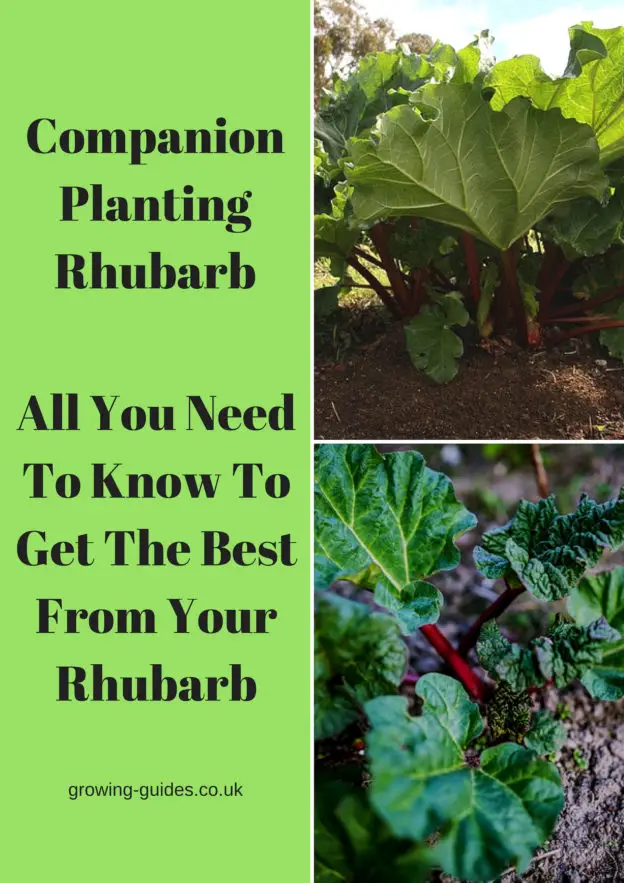
Hi. Thanks for this. Very helpful! Can you share a bit more information about the relationship between rhubarb and roses. I’m thinking of growing a rose up the fence behind my rhubarb and strawberries 🙂
Hi Zoe,
Most pests don’t bother rhubarb because of the chemicals in the leaves that are poisonous.
So growing rhubarb near roses should deter aphids etc…
Also you can make a spray from rhubarb leaves that will keep pests from your roses too.
Growing roses behind rhubarb as you describe should work well.
All the best
Steve
Is it ok to split the crowns of established rhubarb plants whilst full and almost ready to harvest now. (I have an offer from a lady who has a great many rhubarb plants)
Hi John,
To be honest it’s not a good idea to split the crowns during the growing season. They should be split when dormant (during the winter).
If you can wait until next winter they’ll have a better chance of surviving the shock of transplanting and splitting. It takes a lot of energy from the plant to get established. To try to do this qhilst it’s putting it’s energy into growing is a big ask. Possibly take a few now and treat them well, plenty of water and nutrient rich compost, and take more at the end of the autumn.
I hope this helps
all the best
Steve
Hi Steve – thank you so very much for reply. Really didn’t expect a response so quickly, really appreciate your time. Will do exactly what you suggest. Thanks again. Kind regards john.